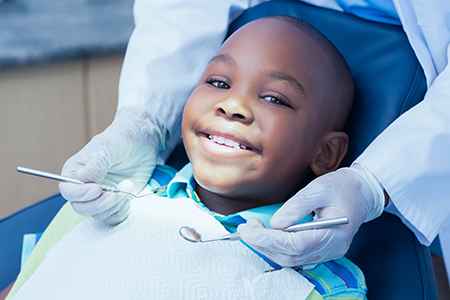
At the office of Value Dental Center, caring for your child’s smile is a responsibility we take seriously. Our pediatric dentistry services are designed to support healthy development, build confident smiles, and make dental care an approachable, reassuring experience for children and their families. We focus on prevention, education, and gentle, age-appropriate treatment so each visit becomes a positive step toward lifelong oral health.

Healthy habits begin long before permanent teeth appear. Early dental visits allow our team to observe how a child's mouth is developing and to introduce simple, practical routines that parents can use at home. We emphasize daily brushing, flossing when appropriate, and establishing predictable hygiene habits that children can gradually take ownership of as they grow.
Preventive care is about more than cleanings; it’s about fostering understanding. We teach children and parents why oral hygiene matters, how diet affects the mouth, and what to watch for as teeth come in. When kids are familiar with the dental environment and the steps involved in care, they are less anxious and more likely to cooperate with treatment when it is needed.
Our approach combines age-appropriate instruction with supportive techniques to make oral care feel manageable and even enjoyable. Simple tools — like colorful toothbrushes, short timers, and fun toothbrushing songs — paired with regular checkups help transform oral hygiene from a chore into a routine that becomes second nature.
First visits set the tone for future care. We design early appointments around familiarization: meeting the team, seeing the tools, and explaining procedures without pressure. This gradual exposure helps children build trust and reduces fear. Our clinical staff is trained to communicate with young patients in ways that are clear, kind, and respectful of each child’s pace.
During routine visits we perform thorough, gentle examinations, and when needed, use digital radiographs to see beneath the surface. These images enable us to detect early signs of decay, monitor eruption patterns, and make informed recommendations — all while minimizing exposure and discomfort. If a cleaning is appropriate, it’s done in a manner that keeps the child comfortable and informed.
We also prepare families for common milestones — from teething to the transition to permanent teeth — offering practical guidance to manage discomfort and encourage healthy progress. If a child needs extra support to remain calm during treatment, we discuss options and plan care with the family so every visit prioritizes safety and emotional well-being.

Regular dental exams allow us to track growth and spot problems before they become more difficult to treat. In a single visit we evaluate the teeth, gums, bite, and jaw function, and review your child’s medical and dental history. Early detection of issues like misalignment, abnormal eruption, or enamel defects often leads to simpler, more effective interventions.
When we recommend diagnostic images, it’s to gain a clearer picture of the developing teeth and jaws. Digital radiography is quick and uses very low radiation; it helps us identify cavities between teeth, check root and bone health, and assess the progress of permanent tooth development. These tools make our preventive strategies more precise.
Professional cleanings remove plaque and tartar in spots that daily brushing may miss, reducing the risk of decay and gum inflammation. We pair clinical care with customized home-care advice so parents feel confident supporting their child’s oral health between visits.
Tooth decay remains one of the most common chronic conditions in children, but it is largely preventable. We focus on practical prevention: fluoride treatments when appropriate, sealants to protect vulnerable chewing surfaces, and clear guidance about limiting frequent exposure to sugary drinks and sticky snacks. Small, consistent changes in routine and diet can dramatically reduce decay risk.
We also work with families to eliminate risky habits that contribute to decay, such as allowing prolonged bottle use with milk or juice. Educating caregivers about nighttime feeding practices, appropriate weaning, and safe snacking helps protect baby teeth until permanent teeth arrive and reduce the need for more invasive care later on.
Begin oral care early: clean gums after feedings and introduce a soft toothbrush when teeth erupt.
Keep sugary drinks and snacks to mealtimes, and favor water between meals to lower cavity risk.
Encourage drying or stopping pacifier and thumb habits by preschool age to support healthy bite development.
Schedule routine checkups and bring your child in at the first sign of discomfort or injury.
Lead by example: brush together, talk about why it matters, and celebrate progress to build positive attitudes.
Protect active smiles with a properly fitted mouthguard when your child plays contact sports.

Infant oral care begins with prevention and gentle routines. Even before the first tooth appears, wiping a baby’s gums after feedings helps reduce bacteria. When teeth start to erupt, parents can use a soft infant brush or a damp cloth to clean surfaces and prevent plaque buildup. These early steps set a foundation for healthy habits.
The American dental organizations encourage a first dental visit around the first birthday or when the first tooth appears. Early visits allow us to advise caregivers on teething comfort measures, safe feeding practices, and how to prevent early childhood caries. Addressing concerns at this stage helps avoid unnecessary complications later.
Teething can be uncomfortable, and families often ask how to help. Cold teething rings, gentle gum massage with a clean finger, and comfort measures can ease symptoms. If parents notice extreme fussiness, fever, or changes in feeding, they should consult the dental team so we can rule out other causes and provide reassurance.
As children progress through elementary school and into their teens, their dental needs change. We continue to monitor tooth eruption, jaw growth, and the alignment of the bite. Early identification of orthodontic concerns allows for timely referrals or treatments that guide jaw development and improve long-term outcomes.
Nutrition plays a central role during growth. A balanced diet rich in vitamins and minerals supports strong teeth and bones, while limiting high-sugar snacks reduces decay risk. We provide practical, age-appropriate advice so families can make food choices that support both general health and oral wellness.
Teenagers face unique challenges: orthodontic appliances, increased independence with oral hygiene, and lifestyle choices that can affect teeth. We work with teens to establish effective at-home routines, recommend protective gear for sports, and clarify how to care for braces or clear aligners so smile goals are met with minimal complications.
Monitoring facial growth is an important part of pediatric dental care. Subtle problems with jaw development or tooth alignment are often most effectively addressed when detected early. If signs suggest orthodontic intervention may be beneficial, we discuss timing and options, and coordinate care with specialists when appropriate.
Encouraging nutrient-dense foods, limiting sugary and acidic beverages, and promoting regular meal patterns help protect teeth and support overall development. We provide families with realistic strategies for balancing treats with healthier options and explain how diet choices relate directly to oral health outcomes.
In every phase — from infancy through adolescence — our goal is to provide clear guidance, gentle treatment, and reliable clinical oversight so children develop healthy, confident smiles. If you’d like to learn more about pediatric dentistry or inquire about care for your child, please contact us for additional information.
A pedodontist is a dentist who has received advanced specialty training in meeting the dental needs of children from infancy to adolescence. Pedodontists, also referred to as "pediatric dentists," study child psychology, behavior management, caring for children with special needs, methods of handling oral/facial trauma, and various techniques for providing anesthesia and sedation. Pedodontists also understand the complexities of facial growth and development and have the clinical skills required to meet the dental needs of all children at every stage of development. Most of all, pedodontists are passionate about what they do and enjoy working with children. They strive to make every dental experience a positive one as they help children establish a strong foundation for good oral health.
Even before your child is born, their first set of teeth is already forming. In fact, by one year of age, some of your baby's front teeth will have already come into place. While the arrival of your baby's first teeth is only one of many developmental milestones, it represents an excellent time to begin a program of oral care. According to recommendations from the American Dental Association, babies should see the dentist around the time of their first birthdays.
Your baby's first teeth typically begin to appear in the 6 to 12-month range. While this is an extraordinary milestone, you need to be aware that your baby may find the experience a little bit uncomfortable. Teething can make babies feel irritable. They may be fussy, have trouble sleeping, not want to eat, and drool quite a bit.
Although you are powerless to speed up the process of teething, there are a few things that you can do to soothe your baby as the new teeth are erupting into place. Common approaches to helping your baby feel more comfortable while getting new teeth, include teething rings or a cold spoon or moist gauze rubbed over their gums.
Even for these few new teeth, it's absolutely essential to establish an effective regimen of oral care. For information on when your baby's first set of teeth will erupt into place, consult this timeline from the American Dental Association: Eruption Charts
Some children persist in sucking their thumbs or fingers beyond their preschool years. For these children, the activity continues to be a source of comfort, relaxation, and security. It may even help them fall asleep at night. However, it's essential to be aware that in the long-term, a finger sucking habit is not healthy.
If your child's thumb or finger sucking habit is still present when the permanent teeth begin to come in, your child is at a higher risk of developing a bad bite. By the age of five or six years, you need to constructively and gently help your child stop the habit.
It's also a good idea to have a comprehensive evaluation at this time. Your pedodontist can assess if there are any habit related alterations to the alignment of your child's teeth or jaws, or if it is affecting their speech or swallowing patterns. They can also discuss habit control strategies with you, as well as follow your child's bite and facial development as they grow. If interceptive appliances or corrective orthodontic care are recommended, the timetable and best options in care will be explained in complete detail.
The American Dental Association and the American Academy of Pediatric Dentistry recommend a dental visit by your child’s first birthday or within six months of the first tooth erupting. Early visits allow the provider to evaluate tooth development, check for early signs of decay, and teach parents age-appropriate home care techniques. Establishing dental care early helps children become comfortable with the office routine and reduces the likelihood of preventable problems later.
During the first visit the dentist or hygienist will perform a gentle exam, review feeding and oral habits, and offer guidance on brushing and fluoride use. Parents will receive practical tips for cleaning emerging teeth and advice about pacifier or bottle-sleeping habits. The visit is brief and focused on prevention and education to set a positive tone for future care.
For most children, routine dental checkups and professional cleanings are recommended every six months to maintain good oral health and catch problems early. Some children with a history of cavities, special medical conditions, or high decay risk may benefit from more frequent visits as advised by the dentist. Regular visits also allow the team to monitor growth, eruption patterns, and oral habits that could affect future development.
At each appointment the clinician will perform a clinical exam of the teeth, gums, and jaws and provide a professional cleaning to remove plaque and tartar. Digital radiographs may be taken when clinically indicated to evaluate areas not visible in the mouth. Your child will also receive personalized oral hygiene instruction and age-appropriate prevention recommendations.
Effective home care begins with supervising toothbrushing and using an age-appropriate amount of fluoride toothpaste: a smear for children under 3 and a pea-sized amount for ages 3 to 6, unless otherwise directed by the dentist. Brushing twice daily and flossing once daily when teeth touch helps remove plaque and reduce the risk of decay. Consistency and parental modeling make oral hygiene part of the daily routine and help children learn responsibility for their own teeth.
Dietary choices also play a major role in cavity prevention; limiting frequent sugary snacks and drinks reduces the time teeth are exposed to decay-causing acids. Encourage water between meals and offer tooth-friendly snacks such as cheese, fruits, and raw vegetables. Avoid putting a baby to sleep with a bottle of milk or juice and replace sweet beverages with water whenever possible.
Dental sealants are a thin, protective coating applied to the chewing surfaces of permanent molars and premolars to block bacteria and food particles from settling in grooves and pits. The application is quick, painless, and often performed after the tooth has erupted enough to be kept dry during the procedure. Sealants are an evidence-based preventive measure that significantly reduces the risk of cavities on treated surfaces.
Sealants are usually recommended when permanent back teeth come in, typically between ages 6 and 14, but the need is evaluated on an individual basis. The dentist will check the integrity of sealants at periodic visits and reapply them if wear or loss is detected. When used alongside good home care and fluoride, sealants offer long-term protection for vulnerable chewing surfaces.
Fluoride is a well-established, safe strategy to strengthen enamel and help prevent tooth decay when used at appropriate levels under professional guidance. In pediatric dentistry fluoride can be delivered topically through in-office varnish or gel applications and through supervised use of fluoride toothpaste at home. The dentist will recommend the appropriate frequency and concentration based on your child’s age, diet, and decay risk.
Parents should follow professional advice on the correct amount of toothpaste and avoid use of adult-strength products unless prescribed. If your child drinks fluoridated tap water, the dentist will consider that in planning supplemental recommendations. Open communication with the dental team ensures fluoride is used safely and effectively as part of an overall prevention plan.
Dental teams use a variety of child-focused techniques to ease anxiety, including tell-show-do explanations, positive reinforcement, and scheduling shorter appointments to build trust and cooperation. Creating a calm, welcoming environment and involving caregivers appropriately can make visits more successful for children of different ages and temperaments. Behavioral guidance is adapted to the child’s developmental level and past experiences to promote a positive association with dental care.
For children with significant anxiety, special needs, or complex treatment needs, the dentist may discuss additional behavior management strategies and, when appropriate, safe sedation options to allow care to be delivered comfortably. Any decision about sedation is made after a thorough medical and dental evaluation and clear communication with the child’s caregiver. These measures help ensure treatment is effective while prioritizing the child’s safety and emotional well‑being.
Thumb sucking and pacifier use are common self-soothing behaviors in infants and young children and typically are not harmful in the earliest years. Concerns arise if the habit persists beyond preschool age, because prolonged sucking can affect tooth alignment and jaw development. The dentist will monitor for dental changes such as open bite, overjet, or altered speech that may indicate the habit is influencing growth.
If the habit continues past ages 4 to 5 or if dental changes are observed, the team can suggest gradual, supportive strategies to help the child stop. Interventions range from positive reinforcement and habit awareness techniques to referral for orthodontic evaluation if structural changes are present. Working together with the dental team provides consistent guidance and improves the likelihood of a successful transition away from the habit.
In the event of a dental injury, remain calm and assess the situation quickly: control any bleeding with gentle pressure, locate any broken or knocked-out tooth, and preserve a permanent tooth by placing it in milk or saline if possible. For a knocked-out permanent tooth, immediate attention is critical because prompt reimplantation offers the best chance for saving the tooth; for a primary (baby) tooth, do not attempt to reinsert it and seek dental advice. Severe tooth pain, swelling, or signs of infection warrant urgent evaluation to relieve discomfort and prevent complications.
After initial first aid, contact your dentist or an emergency dental provider for direction and timely care. If a tooth is fractured, bring any fragments to the appointment so the clinician can assess repair options. Quick, appropriate responses reduce the risk of long-term damage and support the best possible outcome for your child’s oral health.
The American Association of Orthodontists recommends that children have an orthodontic screening by age 7 so that developing problems can be identified early. At that age many children show early signs of misalignment, crowding, or jaw growth discrepancies that can benefit from monitoring or interceptive treatment. An early evaluation does not necessarily mean immediate treatment, but it allows the dental team to plan and time any needed intervention to guide growth effectively.
Your dentist will advise when to refer to an orthodontist or when routine observation is appropriate based on bite, eruption patterns, and facial growth. Early detection of issues such as crossbites, severe crowding, or functional problems can simplify later treatment and sometimes reduce the complexity of orthodontic care. Regular dental visits provide the opportunity to track changes and coordinate any needed specialty care at the optimal time.
Sports mouthguards help prevent dental injuries by cushioning the teeth and supporting structures against impact forces during athletic activity. There are three common types of mouthguards: stock (ready-to-wear), boil-and-bite (moldable at home), and custom-made guards fabricated by a dental professional. Custom mouthguards offer the best fit, comfort, and protection because they are tailored to the child’s mouth and sport-specific needs.
The dentist or hygienist can recommend the most appropriate type of mouthguard based on the sport, level of contact, and the child’s dental development. A well-fitting mouthguard improves compliance and reduces the risk of chipped, fractured, or avulsed teeth and soft tissue injuries. Families that prioritize athletic safety can consult the dental team to obtain or fit the right guard for their child’s sport.
Quick Links